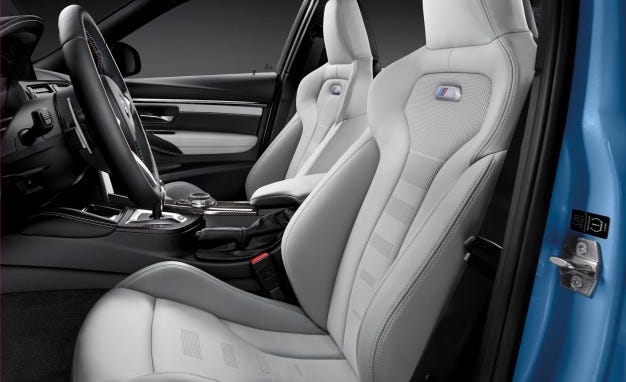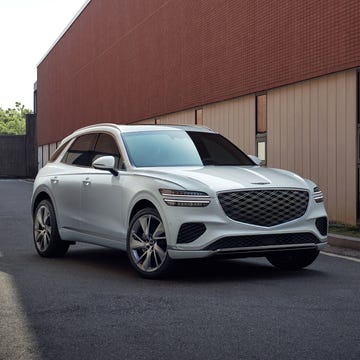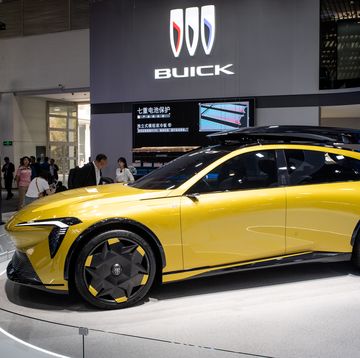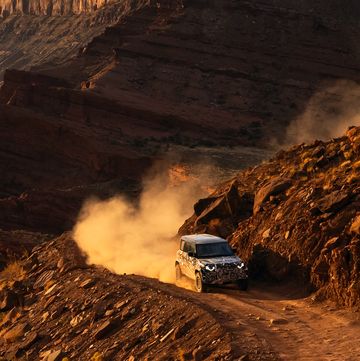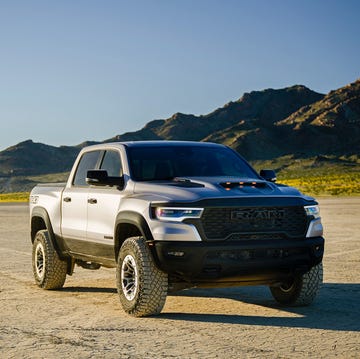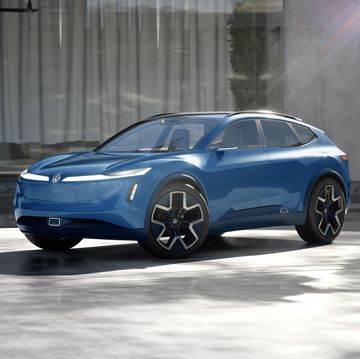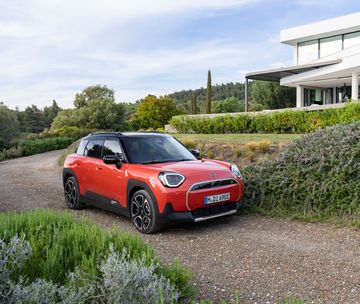We’ve already delivered impressions from our first rides in the 2015 BMW M3 and M4, but now we present some of the minutiae we left out. These 10 details about the legendary coupe and its four-door M3 cohort should fuel your water-cooler conversation at least until the production car debuts in a couple of months. And read even more about the cars from their official debut at the 2014 Detroit auto show.
1. Don’t Call It an F30 (or an F32)
The fifth-generation M3 and the M4 are the first M cars to use different chassis codes than the models they’re based on. The M3 sedan is the F80, not the F30, and the M4 coupe is known as the F82 rather than the F32. The inevitable M4 convertible will use F83, while F81 has been reserved for an M3 wagon. Don’t get your hopes up, though: BMW hasn’t committed to a long-roof M3 for any market. The new internal naming scheme isn’t just a marketing ploy targeted at those who speak the language of BMW. Company officials say that the new chassis codes reflect a change in how the corporate office manages the finance books for these models.
2. The Turbocharged Inline-Six Is Not an N55
Ignore anyone who claims the M3 and M4 engine is a derivative of the N55 engine in the 335i. Both displace 3.0 liters and have six cylinders arranged in a straight line. The similarities end there. The M engine has a larger bore and a shorter stroke than the 335i’s mill at 89.6 and 80.0 millimeters. Not to mention the two (rather than one) unique turbochargers, the forged crankshaft, the dry-sump oiling, and the water-to-air intercooler that make 430 horsepower and 369 pound-feet of torque possible.
3. Think Torque, Not Horsepower
The M3/M4 engine makes a potent 143 horsepower per liter, yet the switch from a naturally aspirated engine to a twin-turbocharged unit has shifted the storyline from power to torque. Until now, every new M3 has brought power gains of at least 50 horsepower. From the E90 to the F80, output has increased by just 16 horsepower, while torque is up 74 lb-ft on the outgoing engine. The twin blowers also provide a torque band that plateaus from about 1800 to 5000 rpm, reducing the need to shift gears as frequently.
4. The Manual Is Saved!
BMW decided years ago that it wouldn’t develop a seven-speed manual, but it hasn’t written off the stick shift completely. A six-speed manual is standard and features a rev-matching program that’s active when the powertrain is in Efficiency and Sport modes. In Sport+ mode, it’s up to the driver to perfect the heel-toe downshift. While we haven’t seen the gear ratios, we’re told that the six-speed uses wider spacing between cogs compared to the previous-generation car’s because of the abundant torque. There’s also a new twin-disc clutch to cope with all the twist.
5. Carbon Fiber Is More Than Skin Deep
The M3 and M4 flaunt a clear-coated carbon-fiber roof (unless you screw up the weight distribution by ordering a sunroof). On the coupe, there’s also a hybrid roof crossmember featuring carbon fiber bonded to steel end pieces that are welded to the body. As with Lamborghini’s Forged Composite, the roof bow uses short strands of randomly placed carbon fiber pressed together, rather than the woven into sheets.
The M4’s trunklid is a combination of low-density sheet molding compound and a carbon-fiber-reinforced sheet molding compound. At the opposite end of the car, you’ll find a sexy, boomerang-shaped carbon-fiber brace connecting the front strut towers to the radiator support. (An aluminum brace connects the towers to the firewall.)
Because of carbon fiber’s stiffness and damping characteristics, the prop shaft from the transmission to the differential is one piece, eliminating the center carrier bearing of the old steel two-piece unit. The total assembly saves 11 pounds. M has made a serious investment in using the light and strong composite material and yet . . .
6. BMW Doesn’t Use Its Own Carbon Fiber on the M3 and M4
In 2009, BMW launched a joint venture with composites supplier SGL Group to manufacture carbon fiber in Moses Lake, Washington. Yet the fibers that come out of that facility are all one size and are earmarked exclusively for the BMW i3 and i8. The carbon-fiber parts on the M3 and M4 require a range of sizes and are made by a variety of suppliers.
7. The Tires are Larger, the Wheels (Probably) Aren’t
The cars we saw and rode in at BMW’s Maisach Driving Experience Center all wore Michelin Pilot Super Sports sized 255/35ZR-19 (92Y) in front and 275/35ZR-19 (100Y) out back. That makes them 0.4 inch wider than the E90’s 19-inch tires. Like all major manufacturers, BMW selects two tire providers to protect itself from supply-chain disruption, so some buyers will find their car arrives with Continental rubber.
We initially assumed the M3 and M4 would be available with a 20-inch wheel-and-tire upgrade, but we’re now convinced that’s not the case. Engineers were cagey when asked point-blank about wheel size, but they later acknowledged that the optional carbon-ceramic brakes require larger wheels. Since a number of the cars on hand were wearing carbon-ceramics with 19-inch wheels, we’re confident that the other wheel is the standard 18-inch piece. Whatever the size, we have been told that both the standard and optional wheels are forged aluminum. For spurning the fashionable in the interest of performance, we say, good on you, BMW.
- Long-Term Road Test Wrap-Up: 2012 BMW 328i Sport Line Manual
- First Drive: 2014 BMW 435i
- Comparison Test: 2013 BMW 335i M Sport vs. 2013 Cadillac ATS 3.6, 2014 Lexus IS350 F Sport
8. You Want the Carbon-Ceramic Brakes
Opting for the carbon-ceramic brake discs also gets you more-aggressive binders. The front calipers are upgraded from four- to six-piston units while four-piston calipers replace two-pot stoppers in the rear. The discs are also larger, although BMW wouldn’t disclose exact dimensions just yet.
9. The M3 Has Better Baseline Aerodynamics than the M4
Look at the M3 and M4 in profile and you’ll notice that the trunklid stretches rearward and the integrated gurney flap is taller on the coupe. That serves to simultaneously reduce drag and lift on the rear axle. The sedan can get away with a smaller spoiler because its longer body creates a better aerodynamic baseline.
10. Yes, It Has Electric Power Steering
We covered this pretty extensively in our first ride, but we’re repeating ourselves here because electric power steering is almost guaranteed to come up in any conversation about the new M3 and M4. If you want to arm yourself with cold, hard knowledge for the inevitable debate, you should start by reading our hydraulic versus electric steering comparison test.

Eric Tingwall holds degrees in mechanical engineering and journalism, a combination he pursued with the dream of working at Car and Driver. While living his dream, he has cut car parts in half, driven into a stationary dummy car at 50 mph, lapped Virginia International Raceway in the hottest performance cars, and explained the physics behind the wacky, waving, inflatable, flailing-arm tube man.



